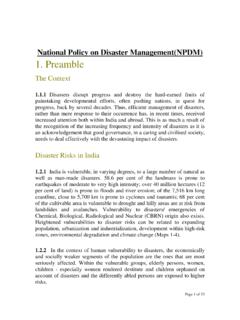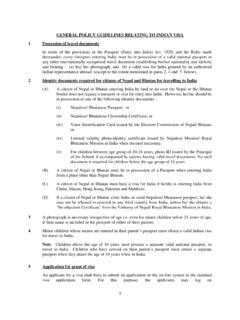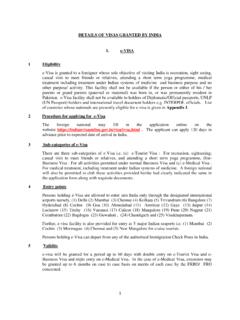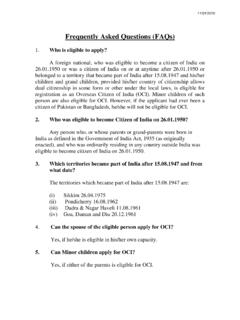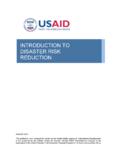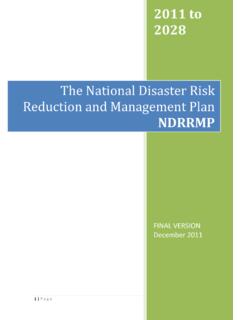Transcription of National Policy on Disaster Management(NPDM) 1. Preamble
1 National Policy on Disaster management (NPDM) 1. Preamble The Context Disasters disrupt progress and destroy the hard-earned fruits of painstaking developmental efforts, often pushing nations, in quest for progress, back by several decades. Thus, efficient management of disasters, rather than mere response to their occurrence has, in recent times, received increased attention both within India and abroad. This is as much a result of the recognition of the increasing frequency and intensity of disasters as it is an acknowledgement that good governance, in a caring and civilised society, needs to deal effectively with the devastating impact of disasters. Disaster Risks in India India is vulnerable, in varying degrees, to a large number of natural as well as man-made disasters.
2 Per cent of the landmass is prone to earthquakes of moderate to very high intensity; over 40 million hectares (12 per cent of land) is prone to floods and river erosion; of the 7,516 km long coastline, close to 5,700 km is prone to cyclones and tsunamis; 68 per cent of the cultivable area is vulnerable to drought and hilly areas are at risk from landslides and avalanches. Vulnerability to disasters/ emergencies of Chemical, Biological, Radiological and Nuclear (CBRN) origin also exists. Heightened vulnerabilities to Disaster risks can be related to expanding population, urbanization and industrialization, development within high-risk zones, environmental degradation and climate change (Maps 1-4). In the context of human vulnerability to disasters, the economically and socially weaker segments of the population are the ones that are most seriously affected.
3 Within the vulnerable groups, elderly persons, women, children - especially women rendered destitute and children orphaned on account of disasters and the differently abled persons are exposed to higher risks. Page 1of 53 Paradigm shift in Disaster management (DM) On 23 December, 2005, the Government of India (GoI) took a defining step by enacting the Disaster management Act, 2005, (hereinafter referred to as the Act) which envisaged the creation of the National Disaster management Authority (NDMA), headed by the Prime Minister, State Disaster management Authorities (SDMAs) headed by the Chief Ministers, and District Disaster management Authorities (DDMAs) headed by the Collector or District Magistrate or Deputy Commissioner as the case may be, to spearhead and adopt a holistic and integrated approach to DM.
4 There will be a paradigm shift, from the erstwhile relief-centric response to a proactive prevention, mitigation and preparedness-driven approach for conserving developmental gains and also to minimise losses of life, livelihoods and property. Page 2of 53 MAP 1 EARTHQUAKE ZONES IN INDIA Page 3of 53 Page 4of 53 Page 5of 53 MAP 4 Page 6of 53 and Objectives Vision To build a safe and Disaster resilient India by developing a holistic, proactive, multi- Disaster oriented and technology driven strategy through a culture of prevention, mitigation, preparedness and response.
5 Disaster management A disaster1 refers to a catastrophe, mishap, calamity or grave occurrence from natural or man-made causes, which is beyond the coping capacity of the affected community. DM involves a continuous and integrated process of planning, organising, coordinating and implementing measures which are necessary or expedient for: Prevention of danger or threat of any Disaster . Mitigation or reduction of risk of any Disaster or its severity or consequences. Capacity building including research and knowledge management . Preparedness to deal with any Disaster . Prompt response to any threatening Disaster situation or Disaster . Assessing the severity or magnitude of effects of any Disaster .
6 Evacuation, rescue and relief. Rehabilitation and reconstruction. A typical DM continuum comprises six elements; the pre- Disaster phase includes prevention, mitigation and preparedness, while the post- Disaster phase includes response, rehabilitation, reconstruction and recovery. 1 Source: Sections 2(d) and (e) of DM Act, 2005. Page 7of 53 A legal and institutional framework binds all these elements together (Diagram I). Fundamental to Prompt and Effective & Continuous IDISASTER management CONTINUUM Approach A holistic and integrated approach will be evolved toward Disaster management with emphasis on building strategic partnerships at various levels. The themes underpinning the Policy are: Community based DM, including last mile integration of the Policy , plans and execution.
7 Capacity development in all spheres. Consolidation of past initiatives and best practices. Cooperation with agencies at National and international levels. Multi-sectoral synergy. Objectives The objectives of the National Policy on Disaster management are: Page 8of 53 Promoting a culture of prevention, preparedness and resilience at all levels through knowledge, innovation and education. Encouraging mitigation measures based on technology , traditional wisdom and environmental sustainability. Mainstreaming Disaster management into the developmental planning process. Establishing institutional and techno-legal frameworks to create an enabling regulatory environment and a compliance regime. Ensuring efficient mechanism for identification, assessment and monitoring of Disaster risks.
8 Developing contemporary forecasting and early warning systems backed by responsive and failsafe communication with information technology support. Promoting a productive partnership with the media to create awareness and contributing towards capacity development. Ensuring efficient response and relief with a caring approach towards the needs of the vulnerable sections of the society. Undertaking reconstruction as an opportunity to build Disaster resilient structures and habitat for ensuring safer living. Promoting productive and proactive partnership with media in Disaster management . Page 9of 53 3. Institutional and Legal Arrangements Disaster management Act, 2005 [[ The Act lays down institutional, legal, financial and coordination mechanisms at the National , state, district and local levels.]]
9 These institutions are not parallel structures and will work in close harmony. The new institutional framework is expected to usher in a paradigm shift in DM from relief-centric approach to a proactive regime that lays greater emphasis on preparedness, prevention and mitigation. Institutional Framework under the DM Act National Disaster management Authority (NDMA) The NDMA, as the apex body for Disaster management , is headed by the Prime Minister and has the responsibility for laying down policies, plans and guidelines for DM (and coordinating their enforcement and implementation for ensuring timely and effective response to disasters) . The guidelines will assist the Central Ministries, Departments and States to formulate their respective DM plans.
10 It will approve the National Disaster management and DM plans of the Central Ministries/Departments. It will take such other measures as it may consider necessary, for the prevention of disasters, or mitigation, or preparedness and capacity building, for dealing with a threatening Disaster situation or Disaster . Central ministries/ departments and State Governments will extend necessary cooperation and assistance to NDMA for carrying out its mandate. It will oversee the provision and application of funds for mitigation and preparedness measures. NDMA has the power to authorize the Departments or authorities concerned, to make emergency procurement of provisions or materials for rescue and relief in a threatening Disaster situation or Disaster .
